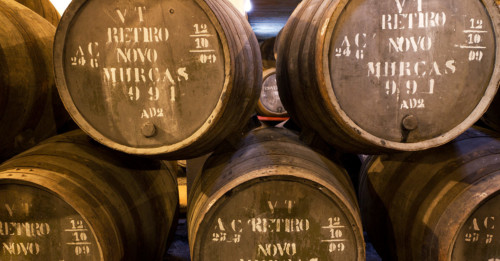Port Essential Info
- Color: Straw gold (white port) to Rich Amber (Tawny) to Reddish Purple (Ruby and Vintage)
- Region: Duoro region of Portugal
- ABV: 16%-20%
- Aged: Yes. Tawny port can be aged for decades (and blended); Vintage port meant to be aged in the bottle; Ruby port is briefly wood-aged and bottled.
- Made from: Grapes, close to 100 permitted for Red Port and half as many for White Port; the 5 most common for Red Port are Tempranillo, Tinta Barroca, Tinta Cao, Tinta Roriz, Touriga Francesca, and Touriga Nacional
- Commercial Examples: Fonseca, Taylor Fladgate, Dow, Fortnum
- Popular Cocktails: The Coffee Cocktail, Elk’s Own, Prey of Thieves
Like Sherry and Vermouth, Port is a fortified (but not aromatized) wine, meaning it’s wine plus a stronger ABV neutral spirit, generally aged, and yes, sipped out of special little glasses. But port’s more than the sum of old school stereotypes—it spans the gamut from refreshingly juicy to richly complex.
And it starts like wine, with a blend of grapes being crushed and fermented (and agitated, basically knocking as much flavor out of the grapes as possible). Unlike wines, which may feature single grape varietals, port production is about the art of blending. But what really differentiates port is fortification: about halfway into fermentation, a neutral spirit is added, killing all the yeast (since higher ABV levels are actually toxic to yeast). Depending on if and how it’s treated next, you’ll get one of four kinds of port.
We’ve all probably heard the term “tawny port” (it kind of sounds like something you’d christen a yacht), but there’s also vintage, ruby, and white. Don’t worry, lots of labelling regulations (courtesy of the Instituto dos Vinhos do Duoro e do Porto) make it pretty clear what’s what. Vintage port is easy to lock down: if a vintage was great, the port is bottled and sold, the idea being it should be aged in the bottle by the consumer (which won’t do what wood-aging does, but theoretically allows the aromatic and flavorful complexity of the port to cohere into a rich, sophisticated unity). Non-vintage ruby ports are actually sent to age for a few years in a wood vessel, then bottled for immediate drinking, resulting in juicy, fruity ports that are great as aperitifs.
And then there’s tawny, one of the more fun but confusing terms in drinking, which actually just refers to a port that blends proportions of non-vintage port that’s been hyper-aged in small wooden barrels for decades (the smaller barrel means even more exposure to wood, increasing the effects of aging). The older the tawny port, the more wood character you’ll get, which is why tawny port (as opposed to vintage) is the more intense differentiation—woody, sweet, with notes of lighter dried fruit.
As for white ports, the concept is essentially the same, except it’s done with dry, white Portuguese grapes, resulting in a lighter, more delicate port with light fruit flavors that’s also a good aperitif and can be aged to fuller complexity.
